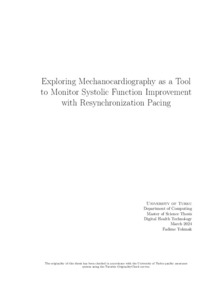Exploring Mechanocardiography as a Tool to Monitor Systolic Function Improvement with Resynchronization Pacing
Tokmak, Fadime (2024-04-04)
Exploring Mechanocardiography as a Tool to Monitor Systolic Function Improvement with Resynchronization Pacing
Tokmak, Fadime
(04.04.2024)
Julkaisu on tekijänoikeussäännösten alainen. Teosta voi lukea ja tulostaa henkilökohtaista käyttöä varten. Käyttö kaupallisiin tarkoituksiin on kielletty.
avoin
Julkaisun pysyvä osoite on:
https://urn.fi/URN:NBN:fi-fe2024041517886
https://urn.fi/URN:NBN:fi-fe2024041517886
Tiivistelmä
The thesis explores the utilization of mechanocardiography (MCG) as a novel approach to assess and quantify improvements in systolic cardiac function resulting from cardiac resynchronization therapy (CRT). The study focuses on patients with heart failure and reduced ejection fraction (HFrEF), a population commonly treated with CRT. The primary objective is to investigate the differences in MCG waveforms during CRT and single-chamber atrial (AAI) pacing, specifically comparing waveform characteristics. 10 patients with heart failure and previously implanted CRT pacemakers were included in the study. The MCG and ECG signals are recorded using accelerometers, gyroscopes, and Holter measurement unit placed on the lower chest and used in the analysis. ECG and MCG recordings were obtained during both CRT and AAI pacing at a consistent heart rate of 80 beats per minute. The analysis involved considering six MCG axes and three MCG vectors across various frequency ranges to derive key waveform characteristics such as energy, vertical range, electromechanical systole (QS2), and left ventricular ejection time (LVET). The results revealed significant differences between CRT and AAI pacing, with CRT consistently exhibiting higher energy and vertical range during systole across multiple axes. Notably, the study identified optimal differences in SCG-Y, GCG-X, and GCG-Y axes within the 6–90 Hz frequency range. However, any difference in QS2, LVET and waveform characteristics around aortic valve closure was not identified between the pacing modes.
The findings suggest that MCG waveforms can serve as indicators of improved mechanical cardiac function during CRT. The use of accelerometers and gyroscopes may contribute to the development of a non-invasive and potentially predictive tool for optimizing CRT settings. The promising results underscore the need for further research to explore the differences in signal characteristics between responders and nonresponders to CRT. The overall aim is to enhance the clinical application of MCG, leveraging wearable technology and micro-electromechanical systems (MEMS), and ultimately improve the optimization and efficacy of CRT in heart failure (HF) management.
The findings suggest that MCG waveforms can serve as indicators of improved mechanical cardiac function during CRT. The use of accelerometers and gyroscopes may contribute to the development of a non-invasive and potentially predictive tool for optimizing CRT settings. The promising results underscore the need for further research to explore the differences in signal characteristics between responders and nonresponders to CRT. The overall aim is to enhance the clinical application of MCG, leveraging wearable technology and micro-electromechanical systems (MEMS), and ultimately improve the optimization and efficacy of CRT in heart failure (HF) management.
